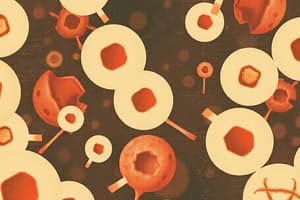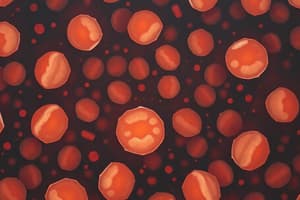Podcast
Questions and Answers
What should be avoided when caring for a patient with conditions that inhibit platelet function?
What should be avoided when caring for a patient with conditions that inhibit platelet function?
- Suctioning unless absolutely necessary (correct)
- Ambulating the patient without assistance
- Taking rectal temperatures (correct)
- Using an electric razor for shaving
Which intervention is NOT advisable for a patient at risk of bleeding?
Which intervention is NOT advisable for a patient at risk of bleeding?
- Administering platelets as prescribed
- Using only soft-bristled toothbrush for oral hygiene
- Applying direct pressure to bleeding sites
- Inserting indwelling catheters (correct)
What position should a patient with epistaxis be placed in to help control bleeding?
What position should a patient with epistaxis be placed in to help control bleeding?
- Trendelenburg position
- Supine position
- Lateral position
- High Fowler's position (correct)
Which of the following does NOT constitute a priority nursing diagnosis for a patient newly diagnosed with leukemia?
Which of the following does NOT constitute a priority nursing diagnosis for a patient newly diagnosed with leukemia?
Which of the following is NOT part of the management for controlling constipation in a patient at risk for bleeding?
Which of the following is NOT part of the management for controlling constipation in a patient at risk for bleeding?
What is the primary focus of care for a patient diagnosed with leukemia?
What is the primary focus of care for a patient diagnosed with leukemia?
Which lab test is least necessary for the diagnosis of chronic myelocytic leukemia?
Which lab test is least necessary for the diagnosis of chronic myelocytic leukemia?
What type of items should a nurse recommend to a patient for oral hygiene in the context of a bleeding disorder?
What type of items should a nurse recommend to a patient for oral hygiene in the context of a bleeding disorder?
What is a common risk factor associated with the development of leukaemia?
What is a common risk factor associated with the development of leukaemia?
Which type of leukaemia is characterized by an acute onset and the presence of immature blast cells?
Which type of leukaemia is characterized by an acute onset and the presence of immature blast cells?
Which cell type primarily fights bacterial infections and is considered essential in this role?
Which cell type primarily fights bacterial infections and is considered essential in this role?
What is the average lifespan of an erythrocyte in the human body?
What is the average lifespan of an erythrocyte in the human body?
Which leukaemia is most commonly associated with the Philadelphia chromosome?
Which leukaemia is most commonly associated with the Philadelphia chromosome?
What is a common manifestation of Acute Myeloblastic Leukaemia?
What is a common manifestation of Acute Myeloblastic Leukaemia?
Which nursing diagnosis is most appropriate for a patient with leukaemia experiencing severe malaise and anorexia?
Which nursing diagnosis is most appropriate for a patient with leukaemia experiencing severe malaise and anorexia?
What is the primary treatment approach for leukaemia?
What is the primary treatment approach for leukaemia?
What symptom is specifically related to thrombocytopaenia in a leukaemia patient?
What symptom is specifically related to thrombocytopaenia in a leukaemia patient?
Which leukaemia is characterized by the accumulation of small, abnormal, mature lymphocytes?
Which leukaemia is characterized by the accumulation of small, abnormal, mature lymphocytes?
Flashcards are hidden until you start studying
Study Notes
Introduction to Leukaemia
- Abnormal overproduction of leukocytes occurs primarily in the bone marrow.
- Immature white blood cells (WBCs), known as blast cells, proliferate and suppress normal bone marrow function.
- Main characteristics include:
- Replacement of normal bone marrow with malignant immature WBCs.
- Presence of abnormal immature circulating WBCs.
- Infiltration into organs such as the liver, spleen, and lymph nodes.
Causes and Risk Factors
- Etiology is often unknown; potential genetic damage leads to malignancy.
- Risk factors encompass:
- Genetic predispositions (e.g., Down syndrome).
- Viral infections (e.g., HTLV-1).
- History of aggressive chemotherapy affecting the immune system.
- Environmental exposures, including ionizing radiation, benzene, and certain medications.
Cell Types and Functions
- Key white blood cell types and their roles:
- Neutrophils: Prevent bacterial infections via phagocytosis.
- Monocytes: Differentiate into macrophages, important in fungal defense and immune surveillance.
- Eosinophils: Engage in allergic reactions by neutralizing histamine and digesting foreign proteins.
- Basophils: Contain histamine, crucial for hypersensitivity responses.
- Lymphocytes: Vital part of the immune system, with subtypes:
- T lymphocytes: Mediate cell-mediated immunity.
- B lymphocytes: Generate antibodies; develop into plasma cells.
- Plasma cells: Secrete immunoglobulins (antibodies).
- Erythrocytes (RBCs): Carry oxygen via hemoglobin; average lifespan is 120 days.
- Platelets (Thrombocytes): Essential for blood coagulation; average lifespan is 10 days.
Classification of Leukaemias
- Classifications are based on acuity and cell types:
- Acute Leukaemias: Rapid onset with immature cells; untreated often fatal within weeks.
- Chronic Leukaemias: Slower progression with mostly mature leukocytes; generally better prognosis.
- Lymphocytic (Lymphoblastic): Affects immature lymphocytes.
- Myelocytic (Myeloblastic): Involves myeloid stem cells, impacting development of blood cells.
- Types include acute myeloblastic, chronic myelocytic, acute lymphoblastic, and chronic lymphocytic leukaemia.
Types of Leukaemia
Acute Myeloblastic Leukaemia (AML)
- Characterized by excess myeloblast proliferation and hyperplasia of bone marrow and spleen.
- Symptoms include fever, infections, bleeding, and weight loss.
- Diagnoses reveal immature blast cells and thrombocytopaenia.
Chronic Myelocytic Leukaemia (CML)
- Result of myeloid stem cell mutation, often linked to the Philadelphia chromosome translocation.
- Symptoms can be mild but include fatigue and splenomegaly.
- Exhibits three phases: chronic, transformation, and terminal blast crisis.
Acute Lymphoblastic Leukaemia (ALL)
- Rapidly proliferates precursor B or T lymphocytes; common in children.
- Symptoms include headaches, vomiting, and pain due to organ infiltration.
Chronic Lymphocytic Leukaemia (CLL)
- Accumulation of abnormal, mature lymphocytes, predominantly B lymphocytes.
- Manifestations include fatigue, infections, and abdominal pain.
Diagnostic Investigations
- Full blood count may show a normal leukocyte count with decreased normal cell percentages.
- Bone marrow aspiration/biopsy assesses disease characteristics and extent.
- Lumbar puncture may evaluate central nervous system involvement, particularly for ALL.
Treatment Approaches
- Primarily involves chemotherapy, with possible radiation and stem cell transplantation.
- Phases of chemotherapy include induction, intensification, CNS prophylactic, and maintenance.
Nursing Diagnoses and Management
- Priority nursing diagnoses may include risk for infection and impaired physical mobility due to isolation.
- Nursing management focuses on preventing and managing infections and bleeding, effective pain control, and maintaining nutrition and physical activity.
Complications Prevention
- Perform oral care with soft-bristled toothbrushes; no flossing allowed.
- Avoid medications that inhibit platelet function and use electric razors for shaving.
- Apply caution during venipuncture and control any bleeding with direct pressure.
Multiple Choice Questions Insights
- Recognizing risk for infection as the priority nursing diagnosis for newly diagnosed leukaemia patients.
- Understanding necessary diagnostic investigations for conditions like chronic myelocytic leukaemia, including blood culture and bone marrow aspiration.
Studying That Suits You
Use AI to generate personalized quizzes and flashcards to suit your learning preferences.




